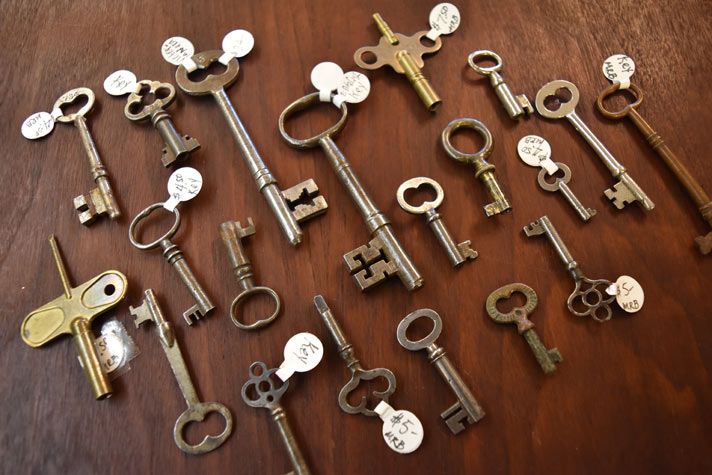Speaking of Antiquing – April 2017
The earliest known door keys were large wooden shafts designed to lift a pin tumbler lock that held a crossbar across a door. The shaft, or key, would push the beam in or out of position from the door frame. This crude Egyptian design was replaced by a Roman invention using keys made of bronze or iron to force metal pin-tumbler lock that moved the beam aside. This concept created obstructions, or “wards,” in the lock through which the key must pass to work, making it unique to the door.
The Romans and Chinese are both given credit for developing the portable padlock. They were immediately popular since they could be used to lock many household items including cupboards, jewelry boxes, safes, trunks, as well as doors. Having many keys became a status symbol and you were considered wealthy if you carried many keys on a ring, as you had much to secure.
An antique key has three basic parts. The handle part you turn is called the “bow;” the tab part that operated the lock is called the “bit,” with both connected by the “shank.” Keys of this type were referred to as “bit” or “barrel keys.” Bit keys had a solid shank and barrel keys had a hallow shank, frequently called “skeleton” keys today. This is a misnomer as a skeleton key is designed to open more than one door.
Great ornamentation was given to making keys. Many keys were commissioned to resemble the door to which they belonged. Many churches used keys with religious symbols on the bow. Superstitions suggested there was healing power in the keys from these great churches, and they were used in healing rituals. Dragonheads were also forged on the bow to keep evil from creeping through the keyhole.
French craftsmen set a high standard to create beautiful and intricately-designed keys, locks, and doorplates with detailed doorknobs. The English were more interested in the technical aspects of the locks. They rarely put ornamentation on them, and were more interested in making locks that were difficult to pick. In the late 1700’s, they developed a double-acting tumbler lock and in 1784 Joseph Bramah patented a safety lock that opened with a cylindrical key that need to be exactly right to turn the bolt.
One hundred years later, the American, Linus Yale, and his son, invented the cylinder lock that we know as the pin-tumbler, still in use today. The key has a blade instead of a shank, with horizontal grooves that allow the key to pass the wards in the cylinder. The cuts or “bittings” operate the pins inside the lock allowing the cylinder to turn freely.
Antique keys are commonly found in most antique shops so you should have no problem collecting keys. Many people like to wear them as jewelry. They are symbolic of “opening one’s heart” and are also given as gifts of love.
Whatever your reason to collect keys, you’ll find them at Pickety Place.

 Margaret Barns is co-owner of Pickety Place Antiques & Collectibles located at 130 N. 4th Street in Jacksonville. LIKE them on
Margaret Barns is co-owner of Pickety Place Antiques & Collectibles located at 130 N. 4th Street in Jacksonville. LIKE them on